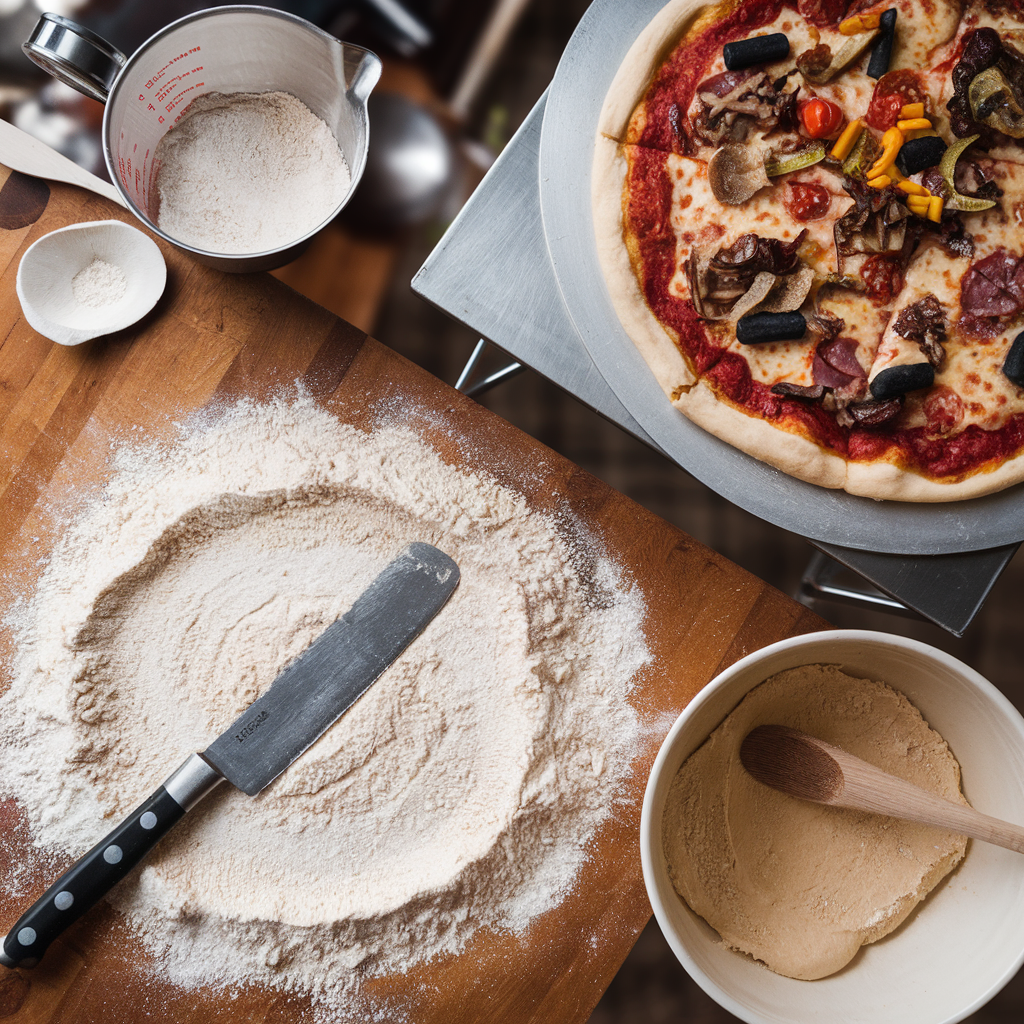Making pizza dough from scratch can seem intimidating, but with the King Arthur pizza dough recipe, you can create a perfect, restaurant-quality crust every time. Whether you’re a beginner or a seasoned home chef, the King Arthur Flour recipes are known for their consistency, flavor, and ease of use. By following this simple yet detailed guide, you’ll be able to make delicious, crispy pizza dough at home with minimal effort.

Why Choose King Arthur Pizza Dough?
King Arthur Flour is a trusted name in the baking world, known for its high-quality bread flour, which plays a crucial role in creating the perfect pizza dough. Their recipe uses a blend of simple, pantry-friendly ingredients that yield excellent results every time.
Unlike store-bought dough, which can often be bland or overly chewy, the King Arthur pizza dough gives you a light, crispy crust with the perfect amount of chew. It’s incredibly versatile, whether you’re making thin-crust pizza or a thicker, stuffed pizza.
For a deeper understanding of how the right flour can make all the difference, check out King Arthur Flour’s baking tips for expert advice on flour types and pizza dough techniques.

Key Ingredients You Need for the Best Pizza Dough
Before you begin, make sure you have these essential ingredients on hand. The beauty of this recipe lies in its simplicity, using just a few quality ingredients to make a great dough.
- King Arthur Bread Flour – This high-protein flour gives the dough structure and elasticity, helping it rise beautifully and hold its shape.
- Active Dry Yeast – Yeast is the magic ingredient that helps the dough rise, creating that airy, light texture we all love.
- Water – Lukewarm water activates the yeast and binds the dough together.
- Salt – Salt enhances the flavor and helps control the yeast’s activity.
- Olive Oil – Adds richness to the dough, contributing to both texture and flavor.
Optional Add-ins:
- Sugar or Honey – For a slightly sweet dough that complements savory toppings.
- Herbs – Rosemary, garlic, or basil can be added to infuse extra flavor into your dough.
To dive into the science of pizza dough and how each ingredient impacts the dough’s final texture, check out this comprehensive guide from Serious Eats.

How to Make King Arthur Pizza Dough Step-by-Step
Follow this straightforward method to make the best pizza dough ever. Whether you’re making Neapolitan-style pizza or something more creative, this recipe will ensure your dough is always on point.
1. Mixing the Dough
Start by combining the dry ingredients in a large mixing bowl:
- 3 cups of King Arthur Bread Flour
- 1 teaspoon of salt
- 1 teaspoon of active dry yeast
Add 1 1/4 cups of lukewarm water to the dry mixture, stirring to combine. Once the dough begins to form, use your hands or a spoon to bring it together.
2. Kneading the Dough
Knead the dough on a floured surface for about 7–10 minutes until it becomes smooth and elastic. If you’re using a stand mixer, use the dough hook attachment and knead on low for about 5 minutes. The dough should be soft but not sticky.
3. First Rise: Proofing the Dough
After kneading, form the dough into a ball and place it in a lightly greased bowl. Cover with a damp towel or plastic wrap, and let it rise in a warm area for 1–2 hours. It should double in size.
For best results, consider slow-fermenting the dough in the fridge overnight. This enhances the flavor and texture of your crust, giving it a slightly tangy taste.
4. Shaping the Dough
Once your dough has risen, punch it down to release the air. Divide it into two portions for thinner crusts or keep it whole for thicker crusts. Roll or stretch the dough into your desired shape, ensuring the edges are slightly thicker for a beautiful crust.
For a detailed explanation on how to stretch and shape your pizza dough, Food52 provides some great tips.

Baking the Pizza
Preheat your oven to 475°F (245°C) and, if you have one, place a pizza stone inside to heat up. A pizza stone helps evenly distribute heat, resulting in a crispier crust.
- If you don’t have a pizza stone, a baking sheet works well. Just make sure to line it with parchment paper for easy cleanup.
- Transfer your shaped dough onto the hot stone or prepared baking sheet.
- Add your favorite pizza sauce, cheese, and toppings.
Bake for about 10–15 minutes, or until the crust is golden and crispy, and the cheese is bubbly and melted. For an extra crispy crust, you can brush the edges with olive oil before baking.

Tips for Perfecting King Arthur Pizza Dough
Once you’ve mastered the basics, experiment with the following tips to take your pizza dough to the next level:
- Hydration Levels: If you prefer a slightly softer dough, add a bit more water. For a more traditional, chewy crust, stick to the recommended hydration levels.
- Kneading by Hand: Kneading the dough by hand gives you more control over the texture. Aim for a smooth, elastic consistency.
- Cold Fermentation: For even more flavor, refrigerate the dough for 24–48 hours. This slow fermentation process develops a deeper taste and chewy texture.

Common Pizza Dough Mistakes to Avoid
Even the best recipe can go wrong if certain steps aren’t followed. Here are some common mistakes to watch out for:
- Under-proofing: Not allowing enough time for the dough to rise can result in a dense, heavy crust.
- Incorrect Oven Temperature: If your oven isn’t hot enough, your pizza crust will be soggy. Preheat your oven to 475°F and make sure it’s fully heated before baking.
- Using the Wrong Flour: The King Arthur Bread Flour is essential for a high-rise, chewy crust. Avoid using all-purpose flour, as it lacks the protein needed to achieve the same texture.
How to Store and Freeze Pizza Dough
If you’re not using the dough immediately, it can be stored in the fridge for up to 2 days or frozen for longer storage. To freeze, divide the dough into individual portions and wrap each tightly in plastic wrap, then store in a freezer bag. Thaw the dough in the fridge overnight before using.
FAQs About King Arthur Pizza Dough
Can I Use Active Dry Yeast Instead of Instant Yeast?
Yes, you can use active dry yeast in place of instant yeast. Simply activate it in warm water for a few minutes before adding it to the dough mixture.
How Long Should the Dough Rise?
The dough should rise for about 1–2 hours at room temperature. If you’re cold-fermenting, let it rise in the fridge for 24–48 hours for even better flavor.
What If My Dough Doesn’t Rise?
If your dough doesn’t rise, it could be due to expired yeast or not enough warmth. Try using fresh yeast and allow the dough to rise in a warmer area, such as near a warm oven.
Can I Use a Pizza Stone for Thin Crust Pizza?
Yes, a pizza stone works perfectly for thin crust pizza, as it distributes heat evenly, creating a crispy crust. Just make sure the stone is preheated before placing the dough on it.
How Do I Get a Crispy Crust with King Arthur Dough?
To get a crispy crust, make sure your oven is at the right temperature (475°F). Additionally, brush the edges of the dough with olive oil before baking for an extra crispy, golden finish.

Conclusion
The King Arthur pizza dough recipe is a foolproof way to make delicious, restaurant-quality pizza right at home. Whether you prefer a thin and crispy crust or a thick and chewy one, this recipe is versatile and easy to customize. By following the steps and tips outlined above, you’ll be able to create the perfect dough every time, impressing your friends and family with your pizza-making skills. If you’re in the mood for something sweet after pizza, consider trying Earl Grey Cookies for a delightful dessert!


